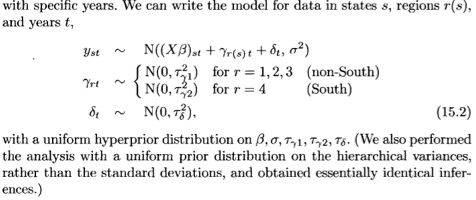I'm looking for a comprehensive description of and justification for a Normal hierarchical model where both the means of the groups and the standard deviation are modelled. It is common to find something like the following model in many textbooks (e.g. Gelman et al., p. 288):
$$y_{ij} \sim \text{Normal}(\mu_i,\sigma) \\ \mu_i \sim \text{Normal}(M, S)$$
where $y_{ij}$ is the $i$th datapoint from group $j$ and where non-informative priors are proposed for $M,S$ and $\sigma$. What I'm looking for is an extension of this model where also the standard deviations of each group are modelled and given hyperparameters (and not only a single $\sigma$ is assumed for all groups). That is something like:
$$y_{ij} \sim \text{Normal}(\mu_i,\sigma_i) \\ \mu_i \sim \text{Normal}(M, S) \\ \sigma_i \sim \text{SomeDistribution}(P_1,P_2,\dots)\\ $$
but where proposals are given for
- The distribution of the $\sigma_i$s ($\text{SomeDistribution}$ in the model above).
- Non-informative prior distributions for the hyperparameters $M, S$ and the parameters of $\text{SomeDistribution}$.
I have not been able to find this in the literature, and my question is: Where can I find this model described in the literature? Or alternatively: What should such a model look like?
References
Gelman, A., Carlin, J. B., Stern, H. S., Dunson, D. B., Vehtari, A., & Rubin, D. B. (2013). Bayesian data analysis. CRC press.

